The iPad Air Review
by Anand Lal Shimpi on October 29, 2013 9:00 PM ESTiPhone to iPad: CPU Changes
Although the iPad Air uses the same A7 from the iPhone 5s (and M7 motion coprocessor), there are a few minor differences that do lead to better performance.
At a high level we’re still talking about two 64-bit Apple Cyclone cores with 128KB L1s (64KB I$ + 64KB D$) per core, a shared 1MB L2 cache and a 4MB L3 cache that services the entire SoC. Apple increased CPU frequency from 1.3GHz to 1.4GHz in the iPad Air, a mild increase but in line with what we’ve seen from previous iPad designs. That’s the first impact on performance - a 7.69% increase in CPU frequency.
The second impact on performance is something I only noticed while digging around under the hood of the A7. It seems like the implementation in the iPad Air can, for whatever reason, hold more instructions in flight (over 20% more) than the A7 in the iPhone 5s. It’s unclear to me whether the A7 in the iPad is configured any differently via firmware/microcode or if perhaps we’re looking at a slightly different revision of the core, but the delta was repeatable in my testing.
The third, and likely biggest change impacting the iPad Air’s implementation of the A7 is the additional thermal headroom afforded by the larger chassis. I’m not going to go into details on exactly what this next test does (unfortunately we’re going to occlude some of the low level work that we do in light of all of the benchmark cheating going on), but we’re looking at a curve of performance vs. time for a particularly power heavy mix of code. We’re running the same exact code on both the iPad Air and iPhone 5s here, the only real difference is the size of the chassis:
You can see the 5s throttles back its CPU frequency to about 1GHz after the 2 minute mark. The crazy thing is that until that point the 5s manages to run at full frequency without so much as a hiccup for two full minutes, running an incredibly power hungry task. Given that most iOS apps aren’t this power intensive for such a sustained period of time, iPhone 5s users should almost always see the A7 running at a full 1.3GHz. Pretty crazy.
The iPad Air by comparison shows much more controlled behavior. Early on in the test we see a 7.7% performance advantage, which lines up perfectly with the iPad Air’s 7.7% CPU frequency advantage. By the end of the test the iPhone 5s has throttled to 900MHz, while the iPad Air drops to around 1.2GHz. At this point the iPad Air’s performance advantage grows to almost 40%.
CPU Performance
I've gone through our standard set of cross-platform browser based benchmarks to place the iPad Air's performance in perspective. As I mentioned in our 5s review, I don't know that there are many (any?) applications on iOS 7 that can really take advantage of all the A7 has to offer. There's definitely a ton of headroom left in the design. What's particularly exciting is when the A7 ends up in n-1 or n-2 iOS devices and it becomes the minimum developer target going forward.
I won't go through all of the results here again, but it's safe to say that the iPad Air is the fastest ARM based tablet on the planet at this point.
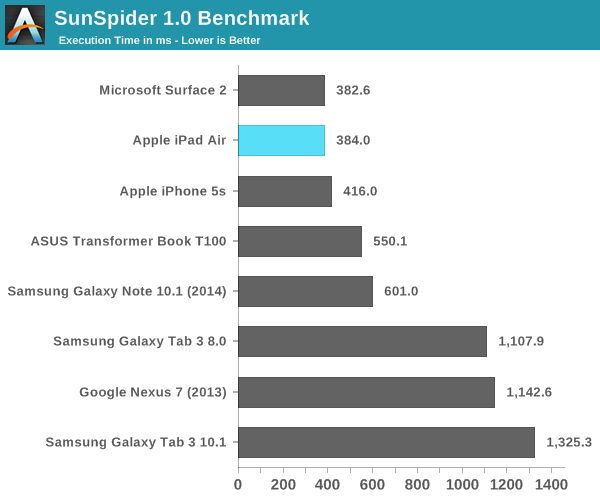
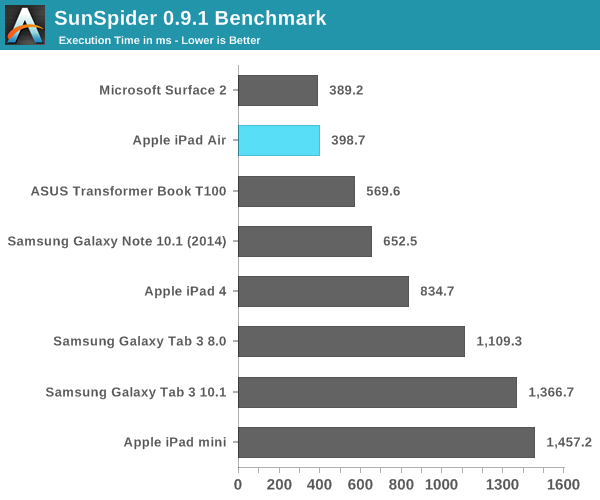
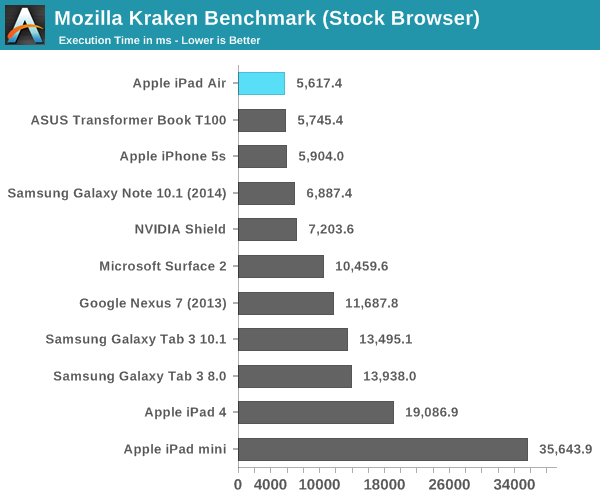
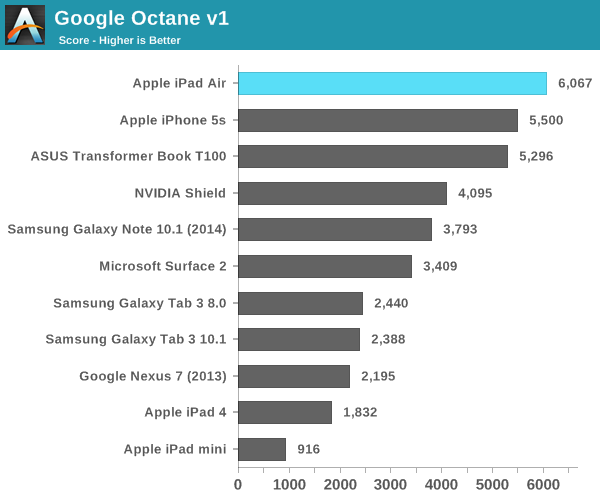
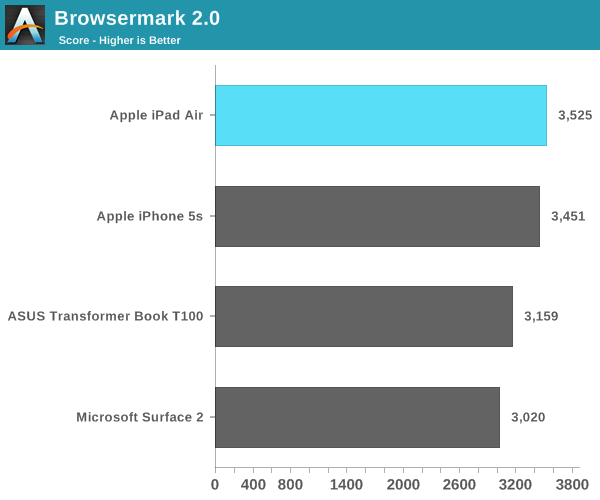

A7 Power Consumption
I’ll get to battery life in a bit, but I’ve been curious about the dynamic range of power consumption offered by Apple’s new A7 SoC. On the one hand we’re dealing with a lower power process (28nm vs. 32nm), but on the other hand Apple’s Cyclone cores can clearly draw more power given how beefy the architecture is this round. Apple frowns upon review sample dissection so I had to turn to a less scientific method of external platform level power measurement. The fidelity of the numbers here aren’t all that great but it’s better than nothing.
For the first test I measured platform power consumption during a Kraken run:
I purposely started measuring before the benchmark so I could get an idea of idle power consumption. The iPad Air consumes roughly 72% of the idle power as the iPad 4, both running at the same brightness. Here we’re not just seeing the A7’s advantages but also things like lower display power.
Focusing on the load portion of the measurement we see that both the new iPad and old iPad consume the same total power in this test. I suspect the A7 is drawing more power than the A6X, but it’s masked by a lower power display. Given how much faster the iPad Air is, Apple’s latest tablet features far lower overall task energy than the outgoing iPad 4. This is probably both the best case scenario for the iPad Air and the most likely case as well.
For kicks I wanted to see just how much power I could get the iPad Air to draw. Here I’m looking at platform power during our mini-power-virus test from above:
How’s that for dynamic range? Almost 12W running all out, but around half that in what we’d normally consider to be a stressful CPU test. I couldn’t get any actual applications/games on the iPad Air to behave like this so the results above are purely academic (for now). A quick run through GFXBench 2.7’s T-Rex HD test confirms that even pushing the GPU won’t hit these numbers. The max I saw running T-Rex offscreen was ~6W, and turning to an actual game (Infinity Blade 3) the iPad Air pulls less than 5W.


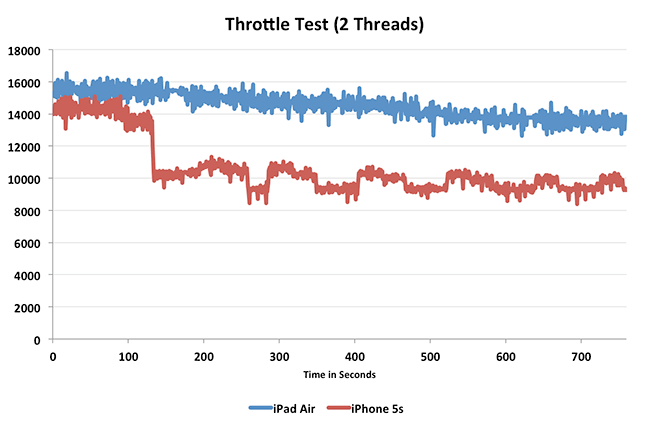
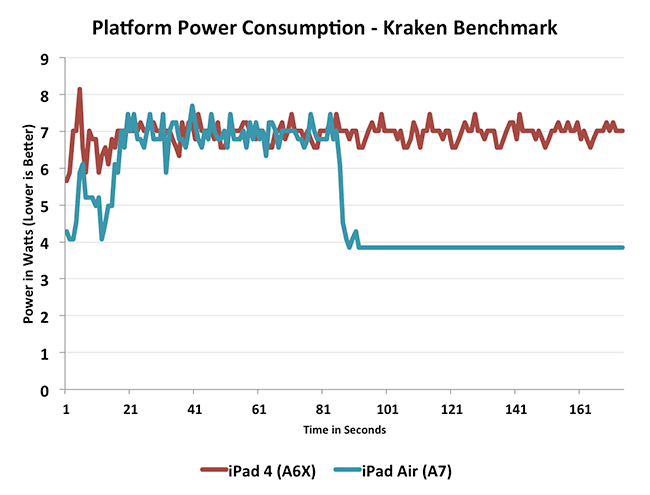
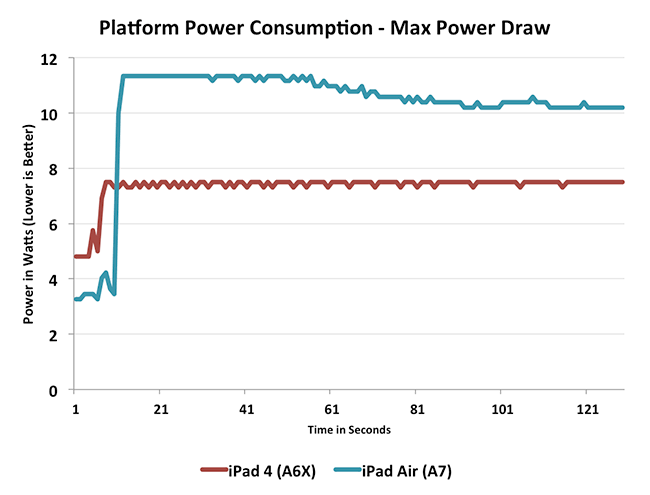








444 Comments
View All Comments
ancientarcher - Wednesday, October 30, 2013 - link
Great review Anand!Looking at the comments it seems that you just can't satisfy everyone. Well done though. Good job!
Having said that, let me now put forward my complaints. Why do you only have javascript benchmarks for the CPU?? I understand there is no ideal CPU benchmark, but what harm will it do to include a few. Nothing is perfect, but if you watch out for the usual tricks that the OEMs/chip suppliers play, you should be able to capture most if not all. Would love to see Geekbench at least in the benchmark set, for both the processor and single core results.
errorr - Wednesday, October 30, 2013 - link
Um, what cross platform benchmark exists? I don't really see any valid possibilities out there right now and nobody is more vocal about it than Anand seems to be.Spunjji - Wednesday, October 30, 2013 - link
"An interesting side effect of Apple’s pricing structure is that the cost for NAND upgrades actually gets pretty reasonable at the higher capacities."That actually made me laugh. I guess that's one way to look at it. From my perspective it's still a rip-off no matter which way you shake it...
VengenceIsMineX - Wednesday, October 30, 2013 - link
Seriously. While it is interesting, this is the one point where I think Anand's affection for Apple products has seriously affected his judgement. He would be just hammering ANY other manufacturer for charging $100 for 16 gb of NAND at today's prices but he not only gives them a pass on that, he bends over backward to point out that 64 GB to 128 GB is "only" another $100. Come on Anand, you are better than that.Spunjji - Tuesday, November 5, 2013 - link
Precisely! Thank you. I can understand the "it's their pricing structure" argument for why they charge that much (people still buy it, so why not) but there's no need to try to make it sound generous when it quite clearly is not.VengenceIsMineX - Wednesday, October 30, 2013 - link
Interesting iteration of hardware, particularly the SOC and a very solid technical review but I think in all fairness Anand, you didn't address the elephant in the room which is Apple's adherence to the $499 full size ipad price point, shameless storage & LTE gouging & what sort of value this offers. With the evolution of great smaller 7" tablets on the Android side and Windows 8.1 Bay Trail devices like the ASUS T100 coming in at prices of less than $230 and $349 respectively, you have to address what sort of value this thing offers for people who will consider it from a value perspective. Sure the Apple faithful will buy it but should those who aren't invested in Apple's ecosystem consider what is a very, very steep price in today's market? You address this in other reviews, why not here?(you do mention the storage pricing but honestly, I think at this point given NAND prices, you would be calling ANY other manufacturer to account for charging $100 for an additional 16 GB of storage, instead you bend over backward to point out how affordable the jump from 64 to 128 is. Really??? That's your take on this????)
darkcrayon - Wednesday, October 30, 2013 - link
I think your assertion about "Apple faithful" is a bit outdated. At the numbers the iPad sells, it's hard to say only a small subset of "special" people who only like Apple are buying them. Obviously a lot of people think the iPad is still worth $500, and you're not going to see a price drop until that changes. I do agree a comparison with inexpensive Windows based tablets is in order though.friendlystanger - Wednesday, October 30, 2013 - link
I am new user of this site and I am nost sure what 2 wide system means. Can anyone clarify this ?errorr - Wednesday, October 30, 2013 - link
It has to do with how many instructions van be processed by a single core on each cycle. It is a major bottleneck but comes with a huge power penalty to go wider usually.Just adding extra cores is only one way to increase parallelism.
friendlystanger - Wednesday, October 30, 2013 - link
Where can I learn more about these things? Any book,tutorial ? BTW thank you very much for your reply.